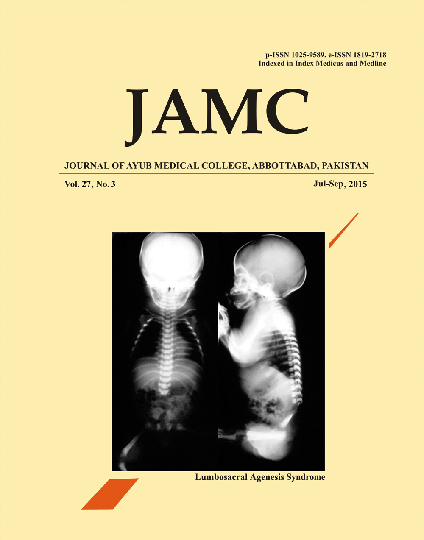EFFECT OF INTRAOPERATIVE MITOMYCIN-C APPLICATION IN OUTCOME OF EXTERNAL DACRYOCYSTORHINOSTOMY
Abstract
Background: Patients develop postoperative fibrosis at the site of operation after dacryocystorhinostomy (DCR) which results in impairment of the osteum patency. This quasi-experimental study was undertaken to determine the role of intraoperative Mitomycin C (MMC) application in maintaining postoperative patency of the osteum. Methodology: The present study was conducted at the Eye department of Ayub Medical College, Abbottabad on patients in whom routine DCR was indicated. Subjects were divided into mitomycin C (Test) and non mitomycin C (Control) groups. In test group, Mitomycin C was applied to the anastomosed flaps and osteotomy site for 30 minutes. Postoperative patients were followed for up to 6 months and outcome of patency was documented. Results: A total of 73 patients were included, divided into test (30) and control (43) groups. An overall success rate of 86.3% was obtained for patent ostia; this was based on 96.67% success in test group compared to 79.1% in the control group (p=0.031). Conclusion: Intraoperative application of Mitomycin-C significantly improves the success rate in external dacryocystorhinostomy.References
Dacryocystitis. (Webpage). Wikipedia the Free Encyclopedia. Accessed May 21, 2015. Available from: URL: https://en.wikipedia.org/wiki/Dacryocystitis.
Pearson Andrew. Lacrimal drainage system (Chapter No. 5). In: Kanski J J. Clinical Ophthalmology. 6th ed. London: Butterworth-Heinemann, 2007:151-64.
Oill PA, Montgomerie JZ, Cryan WS, Edwards JE. Specialty conference. Infectious disease emergencies. Part V: patients presenting with localized infections. West J Med 1977;126(3):196-208.
American Academy of Ophthalmology. Abnormalities of the Lacrimal Secretory and Drainage Systems. In: Orbit, Eyelids, and Lacrimal System. Basic and Clinical Science Course. San Francisco: American Academy of Ophthalmology, 2002:265-300.
Adenis JP, Sommer U, Robert PY. Use of mitomycin C (MMC) for dacryocystorhinostomy interventions. J Fr Ophtalmol 2005;28(4):443-6.
Yildirim C, Yaylali V, Esme A, Ozden S. Long-term results of adjunctive use of mitomycin C in external dacryocystorhinostomy. Int Ophthalmol 2007;27(1):31-5.
Yalaz M, Firinciogullari E, Zeren H. Use of mitomycin C and 5-fluorouracil in external dacryocystorhinostomy. Orbit 1999;18(4):239-45.
Rahman A, Channa S, Niazi JH, Memon MS. Dacryocystorhinostomy without intubation with intraoperative mitomycin-C. J Coll Physicians Surg Pak 2006;16(7):476-8.
You YA, Fang CT. Intraoperative mitomycin C in dacryocystorhinostomy. Ophthal Plast Reconstr Surg 2001;17(2):115-9.
Gonzalvo Ibáñez FJ, Fuertes Fernández I, Fernández Tirado FJ, Hernández Delgado G, Rabinal Arbués F, Honrubia López FM. External dacryocystorhinostomy with mitomycin C. Clinical and anatomical evaluation with helical computed tomography. Arch Soc Esp Oftalmol 2000;75(9):611-7.
Cheng SM, Feng YF, Xu L, Li Y, Huang JH. Efficacy of Mitomycin C in Endoscopic Dacryocystorhinostomy: A Systematic Review and Meta-Analysis. PLoS One 2013;8(5):e62737.
Liao SL, Kao SC, Tseng JH, Chen MS, Hou PK. Results of intraoperative Mitomycin C application in dacryocystorhinostomy. Br J Ophthalmol 2000;84(8):903-6.
Zilelioğlu G, Uğurbaş SH, Anadolu Y, Akiner M, Aktürk T. Adjunctive use of Mitomycin C on endoscopic lacrimal surgery. Br J Ophthalmol 1998;82(1):63-6.
Ghosh S, Roychoudhury A, Roychoudhury BK. Use of Mitomycin C in Endo-DCR. Indian J Otolarngol Head Neck Surg 2006;58(4):368-9.
Downloads
Published
How to Cite
Issue
Section
License
Journal of Ayub Medical College, Abbottabad is an OPEN ACCESS JOURNAL which means that all content is FREELY available without charge to all users whether registered with the journal or not. The work published by J Ayub Med Coll Abbottabad is licensed and distributed under the creative commons License CC BY ND Attribution-NoDerivs. Material printed in this journal is OPEN to access, and are FREE for use in academic and research work with proper citation. J Ayub Med Coll Abbottabad accepts only original material for publication with the understanding that except for abstracts, no part of the data has been published or will be submitted for publication elsewhere before appearing in J Ayub Med Coll Abbottabad. The Editorial Board of J Ayub Med Coll Abbottabad makes every effort to ensure the accuracy and authenticity of material printed in J Ayub Med Coll Abbottabad. However, conclusions and statements expressed are views of the authors and do not reflect the opinion/policy of J Ayub Med Coll Abbottabad or the Editorial Board.
USERS are allowed to read, download, copy, distribute, print, search, or link to the full texts of the articles, or use them for any other lawful purpose, without asking prior permission from the publisher or the author. This is in accordance with the BOAI definition of open access.
AUTHORS retain the rights of free downloading/unlimited e-print of full text and sharing/disseminating the article without any restriction, by any means including twitter, scholarly collaboration networks such as ResearchGate, Academia.eu, and social media sites such as Twitter, LinkedIn, Google Scholar and any other professional or academic networking site.










